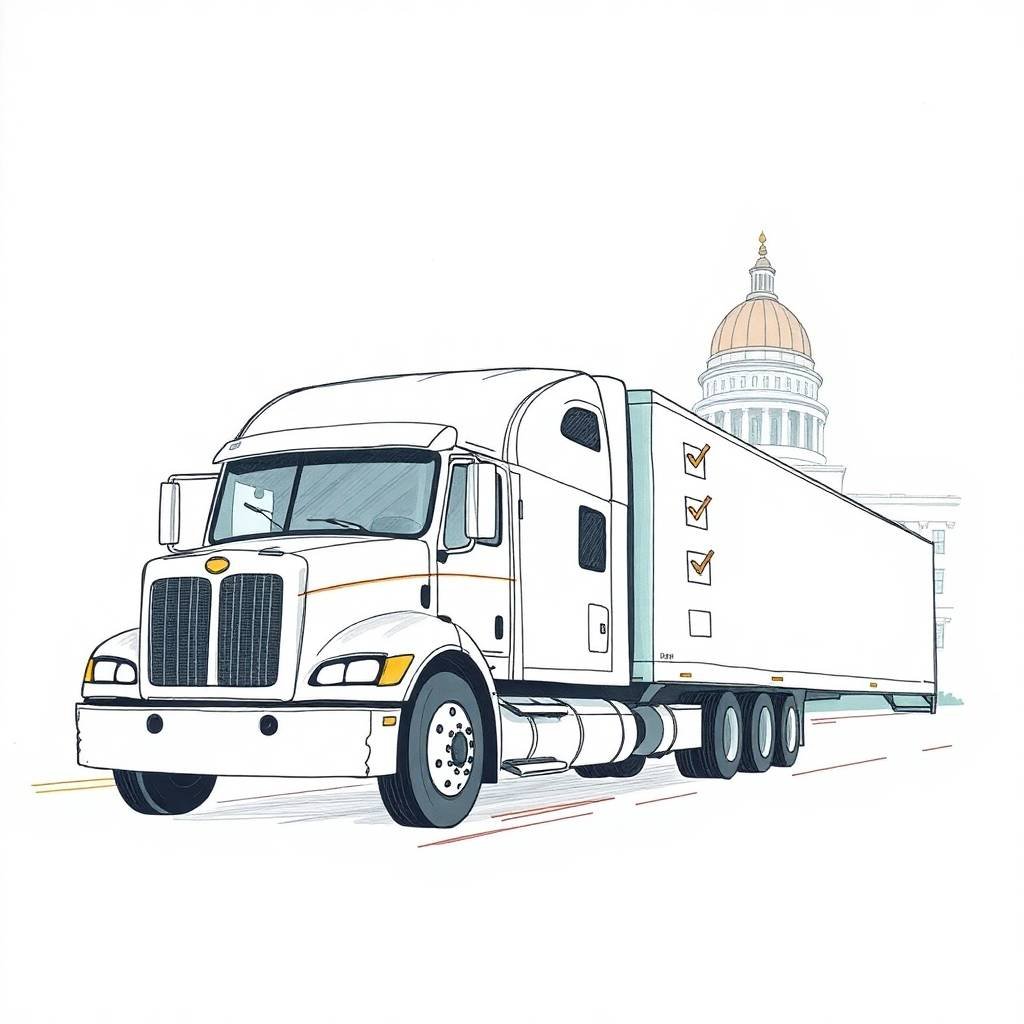1. Understanding the Core of a Driver Drug and Alcohol Testing Program
Ensuring safety and compliance within the trucking industry begins with a robust Driver Drug and Alcohol Testing Program. This program is not only a legal requirement under FMCSA regulations but a critical element in protecting public safety and reducing liability for motor carriers.
What Is a Driver Drug and Alcohol Testing Program?
A Driver Drug and Alcohol Testing Program is mandated by the U.S. Department of Transportation (DOT) and enforced through the FMCSA. The program requires motor carriers to implement pre-employment, random, post-accident, reasonable suspicion, return-to-duty, and follow-up testing for safety-sensitive drivers.
To stay compliant, carriers must maintain proper recordkeeping, align with DOT audit preparation standards, and ensure drivers are enrolled in a program that includes a certified testing facility and a qualified Medical Review Officer (MRO).
Compliance Requirements and Risks
Failing to properly manage a Driver Drug and Alcohol Testing Program can lead to severe consequences, including fines, out-of-service orders, and safety rating downgrades. Many carriers overlook critical details like driver qualification file requirements or DQ file setup and monitoring, resulting in preventable violations.
In fact, one of the most common issues discovered during audits is incomplete or mismanaged DQ file violations, often tied to drug and alcohol program missteps.
FMCSA and Government Oversight
As part of a broader national effort to promote highway safety, oversight of the Driver Drug and Alcohol Testing Program falls under the FMCSA and is supported by legislative backing from the White House. Carriers must also stay up to date with evolving guidelines, as seen in the FMCSA Safety Measurement System (SMS) 2025 update.
For a complete overview of compliance best practices, refer to our FMCSA Compliance Mistakes guide.
Tools and Resources for Carriers
Navigating the complexities of a Driver Drug and Alcohol Testing Program doesn’t have to be overwhelming. At Truckers Compliance Hub, we offer complete drug and alcohol testing management services, along with DOT audit preparation, UCR filing assistance, and IFTA/IRP/BOC-3 support.
Whether you’re an owner-operator or managing a fleet, our dedicated support extends to FMCSA compliance services for owner-operators and trucking companies.
To learn more about the compliance essentials of a Driver Drug and Alcohol Testing Program, explore our in-depth drug and alcohol testing compliance article and our FMCSA Clearinghouse compliance guide.
Schedule a Free Compliance Consultation
Ready to evaluate or improve your current Driver Drug and Alcohol Testing Program? Schedule your appointment with one of our DOT compliance experts today.
You can also view our latest posts for up-to-date regulatory insights and industry news.
For more valuable resources, visit:
Please review our Disclaimer, Privacy Policy, and Terms of Service for more details.

2. Know When and What to Test: A Compliance Timeline
For commercial motor carriers, understanding when and what to test under the Driver Drug and Alcohol Testing Program is essential for staying in compliance with FMCSA regulations. Knowing the required testing events and scheduling timelines not only protects your company from costly penalties but ensures safety on the road.
The Driver Drug and Alcohol Testing Program is a federally mandated initiative regulated by the U.S. Department of Transportation (DOT) and supported by national safety policy through the White House. Its primary goal is to prevent substance misuse among CDL drivers operating commercial vehicles in safety-sensitive functions.
Pre-Employment Testing
Every Driver Drug and Alcohol Testing Program begins with pre-employment testing. Before a driver can perform any safety-sensitive duties, they must pass a DOT-regulated drug test. Employers must also verify the driver’s compliance history using the FMCSA Clearinghouse.
It’s critical to include this step in your driver qualification file setup and monitoring process. Failing to do so is a frequent cause of DQ file violations, which can impact your audit outcome.
Random Testing
Random drug and alcohol tests form the backbone of any compliant Driver Drug and Alcohol Testing Program. Carriers must conduct these tests throughout the calendar year using a scientifically valid method. Mismanagement of this requirement is one of the top FMCSA compliance mistakes carriers make.
Carriers looking to outsource or streamline this process can rely on our drug and alcohol testing management services.
Post-Accident and Reasonable Suspicion Testing
If an accident meets specific DOT criteria or a supervisor observes behavior suggesting drug or alcohol use, post-accident or reasonable suspicion testing must be conducted. These events should be documented as part of your DOT compliance checklist.
Proper training and protocols ensure the Driver Drug and Alcohol Testing Program aligns with FMCSA standards and passes DOT audits.
Return-to-Duty and Follow-Up Testing
Drivers who test positive or refuse to test must complete the return-to-duty process before resuming safety-sensitive duties. This involves a substance abuse professional (SAP) evaluation and multiple follow-up tests, all of which are integral components of your Driver Drug and Alcohol Testing Program.
Our DOT audit preparation service ensures that your documentation supports every stage of testing and recovery.
Stay Current and Compliant
Regulatory updates, such as changes outlined in the FMCSA SMS 2025, impact how you structure your compliance program. Refer to our blog for drug and alcohol testing compliance updates and explore Truckers Compliance Hub for ongoing insights.
For more support, view our specialized solutions for owner-operators and trucking companies.
Take the Next Step
If you’re unsure whether your Driver Drug and Alcohol Testing Program is audit-ready, schedule your appointment today for expert guidance.
Explore related services:
Please review our Disclaimer, Privacy Policy, and Terms of Service before using our services.
Let us help you keep your Driver Drug and Alcohol Testing Program aligned, timely, and fully compliant.
3. Build a Written Policy That Covers All Your Bases
Creating a comprehensive written policy is the cornerstone of a compliant and effective Driver Drug and Alcohol Testing Program. Without a clearly documented framework, trucking companies risk falling short of FMCSA regulations, increasing exposure to fines, failed audits, and unsafe operations. A well-constructed policy doesn’t just support legal compliance — it fosters a culture of accountability and safety within your fleet.
Why Written Policies Matter
A written policy outlines the specific processes and expectations for your Driver Drug and Alcohol Testing Program, including who is subject to testing, when testing occurs, and how results are handled. It’s not just a regulatory formality — it’s a required component of your DOT compliance checklist and a key element during DOT audit preparation.
According to Transportation.gov and reinforced by national safety priorities led by the White House, a strong drug and alcohol policy is crucial for ensuring safety-sensitive roles remain drug-free.
What Your Policy Should Include
To ensure full compliance, your Driver Drug and Alcohol Testing Program policy must include:
- Pre-employment testing procedures
- Random testing protocol
- Post-accident testing rules
- Reasonable suspicion testing guidelines
- Return-to-duty and follow-up testing
- A statement on prohibited behavior and consequences
For a clear breakdown of compliance components, visit our Drug and Alcohol Testing Compliance page.
Common Pitfalls and How to Avoid Them
Many carriers fall into traps by using outdated templates or vague language. These FMCSA compliance mistakes can lead to DQ file violations or issues with the FMCSA Clearinghouse.
To safeguard your operation, consider our expert DQ file setup and monitoring services, designed to keep your documentation airtight and audit-ready.
Managing and Maintaining Compliance
Your Driver Drug and Alcohol Testing Program policy must be consistently updated to reflect changes in federal regulations, such as the upcoming FMCSA Safety Measurement System (SMS) 2025. Policies should also be included as part of your driver qualification file requirements.
Many trucking companies rely on our Drug and Alcohol Testing Management service to handle the complex and ongoing demands of regulatory updates and testing logistics.
Partner With Trusted Compliance Experts
Whether you’re a carrier or an owner-operator, navigating the details of your Driver Drug and Alcohol Testing Program is easier with expert guidance. Start by scheduling your appointment for personalized compliance support.
Visit Truckers Compliance Hub for the latest posts, and explore related services:
Looking for help tailored to your operation? View:
Final Thoughts
An effective Driver Drug and Alcohol Testing Program starts with a written policy that leaves no question unanswered. Don’t risk your company’s reputation or safety score — let us help you build a policy that protects your drivers and your business.
Before proceeding, please review our Disclaimer, Privacy Policy, and Terms of Service.

4. Train Supervisors to Recognize and Respond to Warning Signs
A successful Driver Drug and Alcohol Testing Program doesn’t begin and end with scheduled testing—it hinges on well-trained supervisors who can spot the red flags before a crisis unfolds. When supervisors are equipped to recognize and respond to warning signs, it enhances workplace safety, ensures FMCSA compliance, and protects your company from costly violations.
The Supervisor’s Critical Role
Supervisors are the first line of defense in a Driver Drug and Alcohol Testing Program. Their observations and actions are often what trigger reasonable suspicion testing—a required component of FMCSA regulations. According to Transportation.gov, DOT mandates that supervisors undergo specific training to identify signs of alcohol misuse and controlled substance use among commercial drivers.
In line with national safety initiatives led by the White House, training should not only be comprehensive but also continuously updated.
Warning Signs to Watch For
In a compliant Driver Drug and Alcohol Testing Program, supervisors should be trained to observe physical, behavioral, and performance-related indicators such as:
- Bloodshot eyes or unusual pupil size
- Erratic behavior, mood swings, or aggression
- Unsteady walking or slurred speech
- Frequent absences or reduced productivity
- Accidents or near-misses
Our Drug and Alcohol Testing Compliance guide offers a deeper dive into the signs and legal requirements surrounding testing procedures.
Reasonable Suspicion Training is Not Optional
Without proper training, supervisors may either miss warning signs or act improperly, exposing your fleet to liability. A thorough training module should be part of your DOT compliance checklist, and your company’s policy should align with the FMCSA Clearinghouse Compliance mandates.
You can avoid the most common FMCSA compliance mistakes by investing in specialized training and using tools like our Drug and Alcohol Testing Management service.
Supporting Supervisors with Tools and Documentation
In addition to training, supervisors need access to up-to-date records and policy documentation. Ensuring driver qualification file requirements are met and regularly reviewed can prevent DQ file violations.
Our DQ File Setup and Monitoring service provides an end-to-end solution to keep documentation aligned with FMCSA rules and reduce the risk of audit findings during DOT audit preparation.
Build a Culture of Awareness
By training supervisors within your Driver Drug and Alcohol Testing Program, you create a proactive safety culture. As we move toward the FMCSA Safety Measurement System (SMS) 2025, being ahead of compliance trends is more critical than ever.
Need help getting started? Schedule your appointment today to ensure your team is prepared.
Resources and Support
Explore more at Truckers Compliance Hub, where we offer tailored services including:
- UCR Filing Assistance
- IFTA, IRP & BOC-3 Support
- FMCSA Compliance Help for Trucking Companies
- FMCSA Compliance Services for Owner-Operators
- FMCSA Compliance Services for Owner-Operators 2
Before engaging our services, review our Disclaimer, Privacy Policy, and Terms of Service.
Training your supervisors is not just smart—it’s a requirement. Strengthen your Driver Drug and Alcohol Testing Program with confidence, compliance, and expert support.
5. Selecting the Right Third-Party Administrators (TPAs)
Choosing the right Third-Party Administrator (TPA) is one of the most critical decisions a motor carrier can make when establishing or maintaining a compliant Driver Drug and Alcohol Testing Program. A reliable TPA serves as your partner in ensuring full compliance with FMCSA regulations, minimizing risk, and managing testing procedures seamlessly.
Why Your TPA Choice Matters
Your Driver Drug and Alcohol Testing Program is only as strong as the systems and professionals behind it. The Federal Motor Carrier Safety Administration (FMCSA) and the U.S. Department of Transportation (DOT) require strict adherence to rules governing random testing, post-accident testing, reasonable suspicion testing, and return-to-duty processes.
An experienced TPA not only helps you stay compliant with regulations but also prevents costly FMCSA compliance mistakes that can result in fines or revoked operating authority.
What to Look for in a TPA
When evaluating TPAs for your Driver Drug and Alcohol Testing Program, consider the following:
- Regulatory Knowledge: Ensure the TPA has a thorough understanding of FMCSA Clearinghouse compliance, including required reporting and consent procedures.
- Program Management: Your provider should be able to handle every aspect, from scheduling tests to managing MRO (Medical Review Officer) processes.
- Technology & Reporting: Choose a TPA offering digital dashboards and real-time compliance tracking, aligning with the upcoming FMCSA Safety Measurement System (SMS) 2025.
We offer full Drug and Alcohol Testing Management services that align with FMCSA and DOT guidelines.
How TPAs Support Broader Compliance
A TPA should integrate with your broader compliance strategy, including your driver qualification file requirements, DQ file setup and monitoring, and preparation for DOT audits. They should also alert you to potential DQ file violations or gaps in your DOT compliance checklist.
To strengthen your fleet’s compliance, we recommend exploring our DOT audit preparation and UCR filing assistance as complementary services.
Working With Truckers Compliance Hub
At Truckers Compliance Hub, we specialize in building fully compliant Driver Drug and Alcohol Testing Programs tailored to carriers of all sizes. Our team ensures that your testing processes meet federal standards, and our solutions support long-term success.
Owner-operators and small carriers can benefit from our FMCSA compliance services and compliance support for trucking companies.
For personalized guidance, schedule your appointment now.
Stay Compliant, Stay Informed
The right TPA should offer more than service—they should provide peace of mind. Stay current with federal initiatives through WhiteHouse.gov, and revisit our site for the latest posts and updates.
Before moving forward, please review our Disclaimer, Privacy Policy, and Terms of Service.
When managed properly, your Driver Drug and Alcohol Testing Program becomes a strategic advantage—not just a legal obligation.

6. Maintain Accurate Records for DOT and FMCSA Inspections
Maintaining accurate records is not just a best practice—it’s a legal requirement for any motor carrier operating under the oversight of the Federal Motor Carrier Safety Administration (FMCSA). With increasing scrutiny from both the U.S. Department of Transportation and evolving federal mandates from WhiteHouse.gov, every detail matters, especially regarding your Driver Drug and Alcohol Testing Program.
Why Accurate Recordkeeping Matters
FMCSA and DOT audits require full transparency. Missing or incomplete documentation can lead to serious FMCSA compliance mistakes, costly penalties, and even suspension of operating authority. One area that consistently draws attention is the Driver Drug and Alcohol Testing Program, where documentation must cover pre-employment tests, random tests, post-accident tests, and return-to-duty follow-ups.
You can minimize risk by following a detailed DOT compliance checklist and ensuring every test and result is recorded properly.
Key Records You Must Maintain
To stay inspection-ready, carriers should keep the following records organized and accessible:
- Driver Qualification Files: Ensure you meet all driver qualification file requirements and resolve any DQ file violations proactively.
- Testing Documentation: Your Driver Drug and Alcohol Testing Program must include all relevant documents—testing logs, random selection notices, lab results, and Medical Review Officer (MRO) reports.
- Clearinghouse Records: Full compliance with FMCSA Clearinghouse requirements is crucial, including query history and consent forms.
Our DQ file setup and monitoring and drug and alcohol testing management services can help you keep all these records in order.
Prepare for Audits the Smart Way
DOT and FMCSA inspections can occur with little notice. Ensure your records align with updated guidelines, including changes under the new FMCSA Safety Measurement System (SMS) 2025. Our DOT audit preparation services can walk you through exactly what inspectors are looking for.
Need help staying organized? Learn more about how we assist with UCR filing, BOC-3 filings, IFTA and IRP support, and other regulatory filings.
Trusted Support for Recordkeeping Compliance
At Truckers Compliance Hub, we understand how overwhelming federal recordkeeping can be. Our solutions are tailored to support your Driver Drug and Alcohol Testing Program and ensure all files meet DOT and FMCSA standards. Whether you’re a large carrier or need FMCSA compliance services for owner-operators, we’re here to help.
Explore more tailored resources at FMCSA Compliance Help for Trucking Companies and view the latest posts for industry updates.
Ready to strengthen your compliance strategy? Schedule your appointment today for one-on-one guidance.
Compliance Starts With Transparency
Whether you’re preparing for a routine inspection or building a new Driver Drug and Alcohol Testing Program, staying compliant is about being proactive. For all users, we encourage reviewing our Disclaimer, Privacy Policy, and Terms of Service for complete transparency on our services and advice.
Don’t wait for a DOT audit to reveal gaps in your records—take action now to ensure your compliance strategy is inspection-ready.
7. Handle Positive Test Results the Right Way
Positive test results can be one of the most challenging aspects of managing a Driver Drug and Alcohol Testing Program. However, knowing how to respond appropriately—and lawfully—is essential to maintaining FMCSA compliance, protecting your company, and ensuring public safety.
According to the Federal Motor Carrier Safety Administration and the U.S. Department of Transportation, all employers must take specific steps when a driver tests positive for drugs or alcohol. Failure to follow protocol can lead to serious FMCSA compliance mistakes and threaten your company’s operating authority.
Immediate Steps After a Positive Test
When a driver tests positive under your Driver Drug and Alcohol Testing Program, the first action is immediate removal from safety-sensitive duties. Employers are responsible for ensuring the driver does not operate a commercial motor vehicle until they complete the return-to-duty process.
You must document this action and report the positive result to the FMCSA Clearinghouse, as mandated by federal regulations. Keeping accurate, up-to-date records of all results and actions taken is critical. Our drug and alcohol testing compliance resources can guide you through the correct process.
The Role of a Substance Abuse Professional (SAP)
The driver must be referred to a qualified SAP. The SAP will evaluate the driver and recommend education, treatment, or both before return-to-duty testing can occur. These steps must be documented and retained as part of your Driver Drug and Alcohol Testing Program records.
For support in staying audit-ready, explore our DOT audit preparation service and our comprehensive DOT compliance checklist.
Reinstate Drivers Only After Meeting FMCSA Requirements
Drivers must complete the SAP’s prescribed plan and pass a return-to-duty test before resuming any driving responsibilities. Employers should also be ready to manage follow-up testing schedules. All steps must comply with federal guidelines outlined by both FMCSA and policy priorities set by the White House.
Maintaining detailed records is not just about compliance—it’s also about accountability. Ensure your DQ files and driver qualification requirements are accurate and updated.
Build a Stronger Testing Program
Your ability to handle positive results professionally depends on the strength of your Driver Drug and Alcohol Testing Program. Our drug and alcohol testing management services can help you build or improve your program to meet today’s compliance standards.
We also offer assistance with DQ file setup and monitoring, UCR filing, IFTA/IRP/BOC-3 support, and more.
Resources and Support
For more guidance, explore our insights on the FMCSA Safety Measurement System 2025, FMCSA compliance help for trucking companies, and owner-operator services.
Stay updated by checking out our latest posts and schedule your consultation for personalized compliance support.
Before engaging our services, please review our Disclaimer, Privacy Policy, and Terms of Service.

8. Random Testing: Strategies to Stay Unpredictably Compliant
Maintaining compliance in your Driver Drug and Alcohol Testing Program isn’t just about following regulations—it’s about building a culture of safety and accountability. Random testing is one of the most effective tools to ensure drivers remain drug- and alcohol-free, but it must be done correctly and unpredictably to meet FMCSA requirements.
According to the Federal Motor Carrier Safety Administration, employers are required to perform random testing throughout the year. The purpose of this testing is deterrence. To ensure the success of your program, randomness must be genuine and verifiable.
Understanding FMCSA Requirements for Random Testing
Under your Driver Drug and Alcohol Testing Program, random tests must be spread reasonably throughout the calendar year. The pool must include all safety-sensitive employees, and each driver must have an equal chance of selection during each cycle. Failing to meet this standard can lead to serious FMCSA compliance mistakes.
Stay on top of regulatory changes and ensure full alignment with federal policy updates by following transportation.gov and current safety initiatives promoted by the White House.
Effective Strategies to Maintain Randomness
- Use a TPA or Software for Selection: Leveraging tools or third-party administrators ensures that random selections are statistically valid and legally defensible. Our Drug and Alcohol Testing Management service can assist in this critical area.
- Rotate Testing Dates: Avoid predictable patterns. Rotate days, weeks, and times to prevent manipulation and increase the deterrent effect of your Driver Drug and Alcohol Testing Program.
- Track and Audit Your Program: Keeping your testing documentation well-organized is essential, especially when preparing for inspections. Refer to our DOT Audit Preparation service and our DOT compliance checklist to stay ready.
Documentation and Recordkeeping
Proper recordkeeping is vital for demonstrating compliance during audits. Make sure driver selection logs, testing dates, results, and notifications are well documented. Explore our DQ file setup and monitoring service to stay ahead of DQ file violations.
You’ll also benefit from understanding your obligations under the FMCSA Clearinghouse and monitoring your SMS scores for safety insights.
More Compliance Tools and Resources
Whether you’re an owner-operator or managing a fleet, our team provides tailored support for every size of operation. Check out our:
- FMCSA Compliance Services for Owner-Operators
- UCR Filing Assistance
- IFTA, IRP & BOC-3 Support
- FMCSA Compliance Help for Trucking Companies
Visit Truckers Compliance Hub to read our latest insights or schedule a consultation today.
Final Thoughts
A well-managed Driver Drug and Alcohol Testing Program not only protects your company but also helps meet public safety objectives outlined by national regulators. With proper strategy and expert support, random testing becomes a tool of prevention—not punishment.
Before using our services, please review our Disclaimer, Privacy Policy, and Terms of Service.
9. Stay Aligned with FMCSA and DOT Updates
In the world of commercial transportation, staying informed is not optional—it’s essential. The Federal Motor Carrier Safety Administration (FMCSA) and the Department of Transportation (DOT) frequently issue new regulations and updates that can directly impact your Driver Drug and Alcohol Testing Program. To ensure ongoing compliance and avoid costly penalties, fleet operators and owner-operators must consistently monitor and align with these changes.
The Role of Regulations in Drug and Alcohol Testing
Your Driver Drug and Alcohol Testing Program is a cornerstone of DOT compliance. FMCSA regulations require specific testing schedules, proper documentation, and immediate action on positive results. New rules from the FMCSA and broader transportation policies from transportation.gov often affect how these programs must be administered.
To stay ahead of compliance pitfalls, review our detailed guide on Drug and Alcohol Testing Compliance, which breaks down core responsibilities for motor carriers.
Monitoring FMCSA Updates That Impact Your Program
Policy changes often relate to drug testing thresholds, Clearinghouse reporting, or required documentation. For example, our article on FMCSA Clearinghouse Compliance explains recent mandates for reporting violations, which are directly tied to your Driver Drug and Alcohol Testing Program.
The White House also issues safety and labor initiatives that may influence testing policies. Staying connected with federal sources is crucial, but so is understanding how to apply updates in real-world operations. We help make that connection at Truckers Compliance Hub, where you can schedule a compliance consultation with our experts.
File and Record Management is Crucial
Regulatory alignment extends beyond drug testing—it includes file management. Violations in DQ file requirements and documentation errors are frequent issues we see. To avoid this, explore our DQ File Setup and Monitoring service.
Make sure you’re also reviewing our DOT Audit Preparation for 2025 guide and the DOT Compliance Checklist to stay inspection-ready.
Comprehensive Support for Your Compliance Needs
We understand the challenge of keeping up with changes while running daily operations. That’s why we provide end-to-end services like:
A strong Driver Drug and Alcohol Testing Program needs to be part of a larger compliance framework. This includes aligning with FMCSA Safety Measurement System 2025 standards and avoiding common FMCSA compliance mistakes.
Resources to Stay Current
Whether you operate a single truck or manage a fleet, our compliance services are tailored to your needs:
- FMCSA Compliance Help for Trucking Companies
- FMCSA Services for Owner-Operators
- Owner-Operator Compliance Solutions (Part 2)
For more valuable insights and updates, visit our blog at Truckers Compliance Hub.
Know Your Policies
Before using our services, please review our Disclaimer, Privacy Policy, and Terms of Service.
Staying aligned with the DOT and FMCSA isn’t just about following rules—it’s about running a safer, more efficient operation. Let your Driver Drug and Alcohol Testing Program lead the way in your compliance strategy.

10. Audit-Proof Your Driver Drug and Alcohol Testing Program
The Federal Motor Carrier Safety Administration (FMCSA) holds motor carriers to strict safety and compliance standards. One area where carriers often fall short is the Driver Drug and Alcohol Testing Program. To avoid violations, fines, and potential disqualification during audits, it’s essential to maintain an airtight testing program that meets all federal requirements. The good news? With the right approach and support, you can audit-proof your program and operate with confidence.
Why DOT Compliance Audits Target Drug and Alcohol Testing
Your Driver Drug and Alcohol Testing Program is a primary focus during any DOT audit. Inspectors check for random testing records, pre-employment tests, return-to-duty documentation, and compliance with FMCSA’s Clearinghouse regulations.
If your program is lacking, you risk citations or worse. Learn more in our FMCSA Compliance Mistakes article, which outlines the most common errors carriers make.
Core Elements of an Audit-Proof Program
To maintain a compliant Driver Drug and Alcohol Testing Program, focus on the following:
- Policy Documentation: Ensure your written policy meets FMCSA and DOT regulations outlined at fmcsa.dot.gov and transportation.gov.
- Random Testing Process: Your selection must be scientifically random and managed throughout the year. Learn how to stay compliant in our Drug and Alcohol Testing Compliance guide.
- Driver Files: Every driver should have a complete file, as outlined in our guide on Driver Qualification File Requirements and DQ File Violations.
- Clearinghouse Reporting: You must report violations promptly to FMCSA’s Clearinghouse and ensure return-to-duty procedures are followed.
For a full checklist, review our DOT Compliance Checklist.
Partner With Experts to Avoid Pitfalls
The best way to audit-proof your Driver Drug and Alcohol Testing Program is to partner with experienced compliance professionals. At Truckers Compliance Hub, we offer comprehensive Drug and Alcohol Testing Management and DQ File Setup and Monitoring services.
Need help preparing for a DOT review? Schedule a 30-minute audit-readiness consultation with our team today.
Stay Informed on Regulatory Changes
FMCSA and DOT policies evolve—keeping up is part of staying audit-ready. We recommend following updates directly from the White House, FMCSA, and DOT. You can also subscribe to updates at Truckers Compliance Hub and read insights such as our post on the FMCSA Safety Measurement System 2025.
Additional Compliance Resources
Whether you’re a fleet manager or an owner-operator, we offer services to simplify your compliance burden:
- DOT Audit Preparation
- UCR Filing Assistance
- IFTA, IRP & BOC-3 Support
- FMCSA Services for Owner-Operators
- More Help for Trucking Companies
Know Before You Sign
Please review our Disclaimer, Privacy Policy, and Terms of Service to understand our services and policies.
A strong Driver Drug and Alcohol Testing Program is not just about compliance—it’s about safety, responsibility, and protecting your business. Let us help you stay audit-ready, every step of the way.
What is required for a compliant Driver Drug and Alcohol Testing Program under FMCSA regulations?

A compliant Driver Drug and Alcohol Testing Program must include pre-employment, random, post-accident, reasonable suspicion, return-to-duty, and follow-up testing. It must also incorporate a written policy, supervisor training, and proper recordkeeping. To help ensure all requirements are met, many carriers use professional services like Drug and Alcohol Testing Management, which provide end-to-end compliance support and reduce risk during DOT audits.
How can I ensure my random drug and alcohol tests are conducted fairly and within FMCSA rules?

To maintain fairness and compliance, your Driver Drug and Alcohol Testing Program should use a scientifically valid method for random selection and test throughout the year. Each driver must have an equal chance of selection. Partnering with providers like those featured in our Drug and Alcohol Testing Compliance solutions ensures your random testing process aligns with FMCSA standards and is audit-ready.
What happens if a driver fails a drug or alcohol test?

When a driver fails a test, they must be immediately removed from safety-sensitive duties. Your Driver Drug and Alcohol Testing Program must follow FMCSA’s return-to-duty process, which includes evaluation by a Substance Abuse Professional (SAP) and follow-up testing. Our DOT Audit Preparation services can help ensure your response to failed tests aligns with federal requirements and is properly documented.
Do I need to keep records for all tests in my Driver Drug and Alcohol Testing Program?

Yes, accurate and accessible recordkeeping is critical. Your Driver Drug and Alcohol Testing Program must document all test results, selection methods, notifications, and training records. These records are often reviewed during compliance audits. Using a service like DQ File Setup and Monitoring helps organize these documents and ensures they are up-to-date and audit-ready.
How do I stay updated on changing regulations that impact my Driver Drug and Alcohol Testing Program?

FMCSA regulations can evolve, and it’s vital that your Driver Drug and Alcohol Testing Program adapts accordingly. Regularly review updates on FMCSA Clearinghouse Compliance to ensure your procedures stay current. Additionally, subscribing to industry alert services and partnering with compliance experts can help you proactively manage regulatory changes.
Igor Iturriaga is a transportation compliance expert and founder of Dynamic 305 Miami LLC. He helps owner-operators and fleets stay FMCSA-compliant and audit-ready. https://www.linkedin.com/in/igor-iturriaga-64503217/
